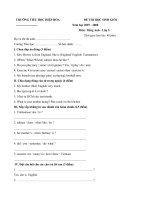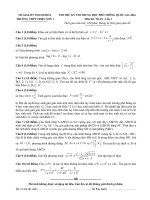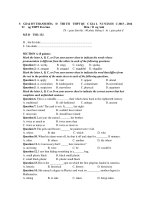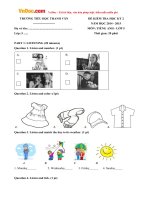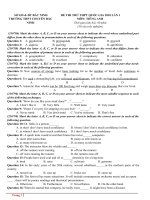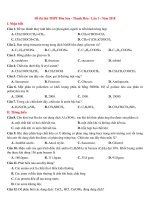- Trang chủ >>
- THPT Quốc Gia >>
- Ngoại Ngữ
Đề thi thử THPTQG 2016 môn Tiếng Anh trường THPT Bỉm Sơn Thanh Hóa lần 1 năm 2016
Bạn đang xem bản rút gọn của tài liệu. Xem và tải ngay bản đầy đủ của tài liệu tại đây (73.15 KB, 10 trang )
SỞ GD & ĐT THANH HÓA ĐỀ THI THỬ THPT QUỐC GIA LẦN I NĂM HỌC 2015 – 2016
Trường THPT Bỉm Sơn
Môn : Tiếng Anh
Thời gian làm bài : 90 phút, không kể thời gian phát đề
MÃ ĐỀ THI: 132
Họ, tên thí sinh:..........................................................................
Số báo danh:...............................................................................
SECTION A (8 points):
Mark the letter A, B, C, or D on your answer sheet to indicate the words whose
pronunciation is different from the others in each of the following questions.
Question 1: A. works
B. stops
C. washes
D. speaks
Question 2: A. amount
B. astound C. mouthful D. shoulder
Mark the letter A, B, C, or D on your answer sheet to indicate the word that differs from
the rest in the position of the main stress in each of the following questions.
Question 3. A. apply
B. visit
C. appear
D. attend
Question 4. A. curriculum B. kindergarten
C. contaminate
D.conventional
Question 5. A. suspicious
B. marvelous
C. physical
D. argument
Mark the letter A, B, C or D on your answer sheet to indicate the correct answer that best
completes each unfinished sentence.
Question 6. This is a valuable ................ chair which dates back to the eighteenth century.
A. traditional
B. old-fashioned
C. antique
D. ancient
Question 7. Look! The yard is wet. It______ last night.
A. must have rained
B. couldn't have rained
C. must rain
D. should have rained
Question 8. Last year she earned _______ her brother.
A. twice as much as
B. twice more than
C. twice as many as
D. twice as more as
Question 9. The girls and flowers ______ he painted were vivid.
A. whose
B. that
C. which
D. who
Question 10. When his alarm went off, he shut it off and slept for ________15 minutes.
A. other
B. others
C. another
D. the others
Question 11. Is it necessary that I _____ here tomorrow?
A. am being
B. were
C. be
D. would be
Question 12. I saw him hiding something in a_______ bag.
A. small plastic black
B. black small plastic
C. small black plastic
D. plastic small black
Question 13.This is the __________spot on which the first pilgrims landed in America.
A. historic
B. historical
C. history
D. historicity
Question 14. She earned a degree in Physics and went on _________ another degree in
Mathematics.
A. taking
B. to take
C. taken
D. being taken
Question 15. Those trousers are far too big. Why don’t you have them___?
A. taken on
B. taken in
C. taken over
D. taken out
Question 16. So little_______about mathematics that the lecture was completely beyond me.
A. I have known
B. I knew
C. do I know
D. did I know
Question 17. I gave the waiter a $50 note and waited for my _________.
A. change
B. supply
C. cash
D. cost
Question 18. I read the contract again and again _________ avoiding making spelling
mistakes.
A. in terms of
B. by means of
C. with a view to
D. in view of
Question 19. Van Gogh suffered from depression ______ by overwork and ill-health.
A. brought on
B. coming about
C. taken up
D. pull through
Question 20. He had spent ____________ time writing an essay on his childhood.
A. a few
B. a large number of C. a great deal of
D. many
Question 21. ________he study harder, he will do better in the exam.
A. Should
B. If
C. When
D. Unless
Question 22. When there are small children around, it is better to put breakable ornaments
out of _________.
A. reach
B. hand
C. place
D. hold
Question 23. Harry:" ______________" Kate: "Yes. I'd like to buy a computer."
A. Do you look for something?
B. Good morning. Can I help you?
C. Excuse me. Do you want to buy it?
D. Can you help me buy something?
Question 24. Tom: “ Sorry, I forgot to phone you last night.” -Mary: “________”
A. I have nothing to tell you.
B. Oh. Poor me!
C. Never mind!
D. You was absent - minded.
Mark the letter A, B, C, or D on your answer sheet to indicate the word(s) CLOSEST in
meaning to the underlined word(s) in each of the following questions.
Question 25. Whenever Susan invites us to dinner, she customarily prepares a lot of
delicious food.
A. naturally
B. necessarily
C. usually
D. certainly
Question 26. It is hoped that illiteracy will soon be eradicated in our country as more and
more people are struggling against it.
A. evolving
B. plunging
C. starting
D. striving
Question 27. His new yatch is certainly an ostentatious display of his wealth.
A. beautiful
B. showy
C. large
D. expensive
Mark the letter A, B, C, or D on your answer sheet to indicate the underlined part that
needs correction in each of the following questions.
Question 28. After writing it, the essay must be duplicated by the student himself and handed
A
B
in to the department secretary before the end of the month.
C
D
Question 29. All of the cities in Texas, San Antonio is probably the most picturesque.
A
B
C
D
Question 30. My cousin composes not only the music, but also sings the songs for the maior
A
B
C
D
Broadway musicals.
Question 31. The Indians of the southwestern United States are famous for their beautiful art
A
work, especially handmade jewelry cast from silver, carved from stones, or decorations with
B
C
D
beads and feathers.
Question 32. Although no country has exactly the same folk music as those of any other, it is
A
B
significant that similar songs exist among widely separated people.
C
D
Read the following passage and mark the letter A, B, C, or D on your answer sheet to
indicate the correct word or phrase that best fits each of the numbered blanks from 33 to
42.
Environmental Concerns
Earth is the only place we know of in the universe that can support human life. (33)
______ human activities are making the planet less fit to live on. As the western world carries
on consuming (34)_______ of the world's resources while half of the world's population do
so just to stay (35)_______ we are rapidly destroying the only resource we have
(36)________ which all people can survive and prosper. Everywhere fertile soil is
(37)______ built on or washed into the sea. Renewable resources are exploited so much that
they will never be able to recover (38)______. We discharge pollutants into the atmosphere
without any thought of the consequences. As a (39)______, the planet's ability to support
people is being reduced at the very time when rising human numbers and consumption are
making increasingly heavy demands on it.
The Earth's (40)______ resources are there for us to use. We need food, water, air,
energy, medicines, warmth, shelter and minerals to (41)______ us fed, comfortable, healthy
and active. If we are sensible in how we use the resources they will last indefinitely. But if we
use them wastefully and excessively they will soon (42)_______ and everyone will suffer.
Question 33: A. Still
B. Despite
C. Yet
D. Although
Question 34: A. two-thirds
B. two- third
C. two-three
D. two-threes
Question 35: A. survival
B. alive
C. existent
D. live
Question 36: A. on
B. at
C. in
D. by
Question 37: A. sooner
B. rather
C. either
D. neither
Question 38: A. completely
B. quite
C. greatly
D. utterly
Question 39: A. result
B. product
C. development
D. reaction
Question 40: A. natural
B. real
C. living
D. genuine
Question 41: A. stay
B. keep
C. maintain
D. hold
Question 42: A. run out
B. run away
C. run up
D. run off
Mark the letter A, B, C, or D on your answer sheet to indicate the word(s) OPPOSITE in
meaning to the underlined word(s) in each of the following questions.
Question 43: The aircraft carrier is indispensable in naval operations against sea or shore
based enemies.
A. unique
B. novel
C. unnecessary
D. exotic
Question 44. This shouldn’t be too taxing for you.
A. comfortable
B. demanding
C. easy
D. relaxing
Read the following passage and mark the letter A, B, C, or D on your answer sheet to
indicate the correct answer to each of the questions from 45 to 54.
Basic to any understanding of Canada in the 20 years after the Second World War is
the country’s impressive population growth. For every three Canadians in 1945, there were
over five in 1966. In September 1966 Canada’s population passed the 20 million mark. Most
of his surging growth came from natural increase. The depression of the 1930’s and the war
had held back marriages, and the catching-up process began after 1945. The baby boom
continued through the decade of the 1950’s, producing a population increase of nearly fifteen
percent in the five years from 1951 to 1956. This rate of increase had been exceeded only
once before settle. Undoubtedly, the good economic conditions of the 1950’s supported a
growth in the population, but the expansion also derived from a trend toward earlier
marriages and an increase in the average size of families. In 1957 the Canadian birth rate
stood at 28 per thousand, one of the highest in the world.
After the peak year of 1957, the birth rate in Canada began to decline. It continued
falling until in 1966 it stood at the lowest level in 25 years. Partly this decline reflected the
low level of births during the depression and the war, but it was also caused by changes in
Canadian society. Young people were staying at school longer; more women were working;
young married couples were buying automobiles or houses before starting families; rising
living standards were cutting down the size of families.It appeared that Canada was once
more falling in step with the trend toward smaller families that had occurred all through the
Western world since the time of the Industrial Revolution.
Although the growth in Canada’s population had slowed down by 1966 (the increase
in the first half of the 1960’s was only nine percent), another large population wave was
coming over the horizon. It would be composed of the children who were born during the
period of the high birth rate prior to 1957.
Question 45. What does the passage mainly discuss?
A. Educational changes in Canadian society.
B. Canada during the Second World War.
C. Population trends in postwar Canada.
D. Standards of living in Canada.
Question 46. According to the passage, when did Canada’s baby boom begin?
A. In the decade after 1911
B. After 1945
C. During the depression of the 1930’s
D. In 1966
Question 47. The word “five” in line 2 refers to__________.
A. Canadians
B. years
C. decades
D. marriages
Question 48. The word “surging” in line 3 is closest in meaning to__________.
A. new
B. extra
C. accelerating
D. surprising
Question 49. The author suggests that in Canada during the 1950’s____.
A. the urban population decreased rapidly B. fewer people married
C. economic conditions were poor
D. the birth rate was very high
Question 50. The word “trend” in line 8 is closest in meaning to__________.
A. tendency
B. aim
C. growth
D. directive
Question 51. The word “peak” in line 11 is closest in meaning to___________.
A. pointed
B. dismal
C. mountain
D. maximum
Question 52. When was the birth rate in Canada at its lowest postwar level?
A. 1966
B. 1957
C. 1956
D. 1951
Question 53. The author mentions all of the following as causes of declines in population
growth after 1957 EXCEPT__________.
A. people being better educated
B. people getting married earlier
C. better standards of living
D. couples buying houses
Question 54. It can be inferred from the passage that before the Industrial Revolution
_________.
A. families were larger
B. population statistics were unreliable
C. the population grew steadily.
D. economic conditions were bad
Read the following passage and mark the letter A, B, C, or D on your answer sheet to
indicate the correct answer to each of the questions from 55 to 64.
Ethology is concerned with the study of adaptive, or survival, value of behavior and
its Evolutionary history. Ethological theory began to be applied to research on children in
the1960’s but has become even more influential today. The origins of ethology can be traced
to the work of Darwin. Its modern foundations were laid by two European zoologists,
Konrad Lorenz and Niko Tinbergen.
Watching the behaviors diverse animal species in their natural habitats, Lorenz, and
Tinbergen observed behavior patterns that promote survival. The most well-known of these is
imprinting, the early following behavior of certain baby birds that ensures that the young will
stay close to their mother and be fed and protected from danger. Imprinting takes place
during an early, restricted time period of development. If the mother goose is not present
during this time, but an object resembling her in important features is, young goslings may
imprint on it instead . Observations of imprinting led to major concept that has been applied
in child development” the critical period . It refers to a limited times span during which the
child is biologically prepared to acquire certain adaptive behaviors but needs the support of
suitably stimulating environment. Many researchers have conducted studies to find out
whether complex cognitive and social behaviors must be learned during restricted time
periods. for example, if children are deprived of adequate food or physical and social
stimulation during the early years of life, will their intelligence be permanently impaired? If
language is not mastered during the preschool years, is the child’s capacity to acquire it
reduced?
Inspired by observations of imprinting, in 1969 the British psychoanalyst John
Bowlby applied ethological theory to the understanding of the relationship between an infant
and its parents. He argued that attachment behaviors of babies, such as smiling, babbling,
grasping, and crying, are built-in social signals that encourage the parents to approach, care
for, and interact with the baby. By keeping a parent near, these behaviors help ensure that the
baby will be fed, protected from danger, and provided with the stimulation and affection
necessary for healthy growth. The development of attachment in human infants is a lengthy
process involving changes in psychological structures that lead to a deep affectional tie
between parent and baby.
Question 55: What was Darwin’s contribution to ethology?
A. Darwin was the first person to apply ethological theory to children.
B. Darwin’s work provided the basis for ethology.
C. Darwin was the professor who taught Lorenz and Tinbergen.
D. Darwin improved on the original principles of ethology.
Question 56: The word “foundations” in line 4 is closest in meaning to______.
A. institutions
B. inventions
C. discoveries
D. researches
Question 57: The word “ensures” in line 7 is closest in meaning to __________.
A. assumes
B. guarantees
C. proves
D. teaches
Question 58: According to the passage, if a mother goose is not present during the time
period when imprinting takes place, which of the following will most likely occur?
A. The mother will later imprint on the gosling.
B. The gosling may not find a mate when it matures.
C. The gosling will not imprint on any object.
D. The gosling may imprint on another object.
Question 59: The word “He” in line 19 refers to __________.
A. an infant
B. a psychoanalyst
C. parent
D. a baby
Question 60: The word “acquire” in line 12 is closest in meaning to __________.
A. gain
B. reach
C. have
D. work
Question 61: The author mentions all of the following as attachment behaviors of human
infants EXCEPT__________.
A. smiling
B. crying
C. eating
D. grasping
Question 62: According to the passage, attachment behaviors of infants are intended
to___________.
A. prepare the infant to cope with separation
B. provide the infant with a means of self-stimulation
C. allow the infant to become imprinted on objects that resemble the parent
D. get the physical, emotional and social needs of the infant met
Question 63: The phrase “affectional tie” in line 24 is closest in meaning to _________.
A. behavioral change
B. psychological need
C. cognitive development
D. emotional attachment
Question 64: It can be inferred from the passage that ethological theory assumes that
__________.
A. failure to imprint has no influence on intelligence
B. to learn about human behavior only human subjects should be studied
C. there are similarities between animal and human behavior
D. the notion of critical periods applies only to animals
SECTION B (2 points):
I.Finish each of the following sentences in such a way that it means the same as the
sentence printed before it.Write your answers on your answer sheet.(0.5points)
Question 1: It is said that the Great Pyramid of Giza was built over a 20-year period.
The Great Pyramid of Giza ………………………………………………………
Question 2: Mary started learning English 3 years ago.
Mary has .............................................................................. …..
Question 3: Mr. Smith knew little about the Internet, so he didn’t invest into any computer
companies.
Had ……………………………………………………………………..................
Question 4: We can’t have breakfast in the garden because it is very cold.
It is so……………………………………………………………………………………..
Question 5: Immediately after his arrival, things went wrong.
Hardly……………………………………………………………………….
II. In about 140 words, write a paragraph about the benefits of playing sports. Write your
paragraph on your answer sheet.(1,5 points).
The following prompts might be helpful to you.
- Keeping fit and healthy
- Entertaining and relaxing
- Earning money
----------- THE END ----------
ĐÁP ÁN ĐỀ THI THỬ THPT QUỐC GIA LẦN I NĂM HỌC 2015 – 2016
1. Đáp án C “es” sau đuôi /∫/ phát âm là /iz/, sau các đuôi /k,p/ phát âm là /s/
2. Đáp án D “ou” trong “shoulder” phát âm là /əʊ/, các từ còn lại phát âm là /aʊ/
3. Đáp án B Trọng âm của từ này rơi vào âm tiết thứ 1, các từ còn lại rơi vào âm tiết thứ 2
4. Đáp án B Trọng âm của từ này rơi vào âm tiết thứ 1, các từ còn lại rơi vào âm tiết thứ 2
5. Đáp án A Trọng âm của từ này rơi vào âm tiết thứ 2, các từ còn lại rơi vào âm tiết thứ 1
6. Đáp án C Antique = cổ (đồ cổ); traditional = truyền thống; old-fashioned = lạc hậu; ancient
= cổ đại
7. Đáp án A Must have + past participle : dự đoán chắc chắn đã xảy ra trong quá khứ dựa trên
cơ sở rõ ràng (sân ướt là cơ sở cho phỏng đoán)
8. Đáp án A Gấp bao nhiêu lần dùng: số lần + as + adj + as +N. Cô ấy kiếm nhiều tiền gấp
đôi anh trai. Danh từ tiền không đếm được, nên ta dùng “much”
9. Đáp án B Đại từ chỉ người làm túc từ cho mệnh đề quan hệ nên dùng “that”. Whose chỉ sự
sở hữu của người. Which chỉ vật. Who bổ nghĩa cho người, thường làm chủ ngữ trong mệnh
đề quan hệ
10. Đáp án C Another + N = thêm một cái khác nữa. other (adj) = khác. Others = những đối
tượng khác. The others = những đối tượng còn lại
11. Đáp án C Cấu trúc giả định: It is + tính từ thể hiện sự quan trọng
(necessary/important/essential…) + S + (should) + V
12. Đáp án C Quy tắc sắp xếp các tính từ: OPSACOM: Opinion– Price – Shape/size (small) –
Age– Color (black) – Original – Material (plastic) => small black plastic
13. Đáp án A Historic = mang tính bước ngoặt quan trọng, mang tính lịch sử; historical =
thuộc về lịch sử, liên quan đến sự kiện lịch sử
14. Đáp án B Go on + Ving = tiếp tục làm gì
15. Đáp án B Have something + past participle = thu xếp để đồ gì của mình được ai tác động.
Take something in = chỉnh sửa, thu nhỏ quần áo
16. Đáp án D Câu đảo ngữ “so” với trạng từ: So + adv + trợ động từ + S + V (không chia) +
that + mệnh đề = quá …đến mức mà
17. Đáp án A Change (n) = tiền lẻ, tiền thừa trả lại
18. Đáp án C With a view to + Ving = với mục đích làm gì
19. Đáp án A
Bring something on = gây ra cái gì
20. Đáp án C A great deal of + N (không đếm được) = nhiều. A large number of = Many + N
đếm được số nhiều = nhiều. A few + N số nhiều = một ít
21. Đáp án A Đảo ngữ câu điều kiện loại 1: Should + S + V = If + S + V(s/es)
22. Đáp án A Out of reach = ngoài tầm với
23. Đáp án B Do you look for something ? = bạn đang muốn tìm kiếm thứ gì à? ( -> câu hỏi
khách đang chọn mua hàng)
24. Đáp án C Never mind! = không có gì (đáp lại câu xin lỗi)
25. Đáp án C Customarily = theo thường lệ
26. Đáp án D Struggle against something = chiến đấu chống lại cái gì. Strive against
something = nỗ lực ngăn cái gì
27. Đáp án B Ostentatious = phô trương; khoe ra. Showy = phô trương
28. Đáp án A Ving đứng đầu câu là hình thức rút gọn chủ động, phải do chủ ngữ của câu thực
hiện. Bài luận (essay) không thể chủ động viết, mà được viết ra -> chuyển thành quá khứ
phân từ (để rút gọn mệnh đề bị động) -> written
29. Đáp án A All of N số nhiều = tất cả. Hai cụm danh từ đứng cạnh nhau -> không hợp
nghĩa. Sửa: Among all (trong số tất cả các thành phố ở Texas)
30. Đáp án A Sau “not only” và “but also” phải cùng loại từ. Sau “but also” là động từ, từ sau
“not only” cũng là động từ. Sửa: not only composes
31. Đáp án D Sửa: decorated. Trước “or” là quá khứ phân từ (carved) – rút gọn cho mệnh đề
quan hệ; sau nó cũng phải là mệnh đề quan hệ. “cast from silver, carved from stones, or
decorations with beads and feathers.” = được đúc từ bạc, khắc từ đá, hoặc được trang trí với
các chuỗi hạt và lông vũ
32. Đáp án B Đối tượng được so sánh ở đây là “folk music” – danh từ số ít -> dùng “as that”
thay vì “as those”
33. Đáp án C Yet = thế nhưng = But. Still = vẫn. Despite = Although = dù
34. Đáp án A Cách viết phân số: Tử số là số đếm; mẫu số là số thứ tự. Khi tử số lớn hơn một
thì phải thêm “s” vào sau mẫu số
35. Đáp án B Stay + adj = sống; duy trì ở tình trạng nào. Alive (adj) = còn sống
36. Đáp án D By = bằng cách nào.
37. Đáp án C Either … or… = …hoặc là…
38. Đáp án A Recover = hồi phục. Completely = hoàn toàn. Quite = khá. Greatly = lớn,
nhiều. Utterly = cực kì, hoàn toàn
39. Đáp án A As a result, mệnh đề = Kết quả là,…
40. Đáp án A Natural resources = các nguồn tài nguyên thiên nhiên
41. Đáp án B Keep somebody + adj/Ved = duy trì ai ở tình trạng nào
42. Đáp án A Run out = hết, cạn kiêt
43. Đáp án C Indispensable = không thể bỏ qua; unnecessary = không cần thiết
44. Đáp án C Taxing = khó khăn, vất vả
45. Đáp án C Bài văn nói về tình trạng dân số của Canada thời hậu chiến. Ngay từ đầu: Basic
to any understanding of Canada in the 20 years after the Second World War is the country’s
impressive population growth
46. Đáp án B Dòng 2: For every three Canadians in 1945, there were over five in 1966 -> cứ
có 3 người Canada năm 1945 thì lại có 5 người năm 1966 -> dân số bắt đầu tăng từ sau 1945
47. Đáp án A Five chỉ 5 sự vật/ đối tượng đếm được nhắc đến ở trước đó; trước đó chỉ nhắc
tới “three Canadians” là danh từ đếm được số nhiều
48. Đáp án C Surging = đang tăng vọt. Accelerating = đang leo thang
49. Đáp án D Từ dòng 5: The baby boom continued through the decade of the 1950’s,
producing a population increase of nearly fifteen percent in the five years from 1951 to 1956.
This rate of increase had been exceeded only once before settle -> sự gia tăng trẻ sơ sinh tiếp
tục vào những năm 1950, khiến dân số tăng lên một nửa trong 5 năm;tốc độ gia tăng này mới
được vượt ngưỡng 1 lần -> tỉ lệ sinh đẻ khá cao
50. Đáp án A Trend = xu hướng = tendency
51. Đáp án D Peak = cực điểm. Maximum = mức cực đại
52. Đáp án A 2 dòng đầu đoạn cuối: Although the growth in Canada’s population had slowed
down by 1966 (the increase in the first half of the 1960’s was only nine percent), another
large population wave was coming over the horizon -> sự tăng dân số chậm lại vào 1966, rồi
lại có một đợt sóng tăng dân số -> tỉ lệ sinh đẻ 1966 là thấp nhất
53. Đáp án B Từ dòng 3,4 đoạn 2: Young people were staying at school longer; more women
were working; young married couples were buying automobiles or houses before starting
families; rising living standards were cutting down the size of families. -> Chỉ có đáp án B
không được đề cập
54. Đáp án A
2 dòng cuối đoạn 2: It appeared that Canada was once more falling in step with the trend
toward smaller families that had occurred all through the Western world since the time of the
Industrial Revolution.
55. Đáp án B Từ dòng 3 đoạn 1: The origins of ethology can be traced to the work of Darwin.
Its modern foundations were laid by two European zoologists, Konrad Lorenz and Niko
Tinbergen
56. Đáp án A Foundation = sự thành lập, institution = sự thành lập, cơ quan
57. Đáp án B Ensure = đảm bảo. Guarantee = bảo đảm, bảo hành
58. Đáp án D Từ dòng 5 đoạn 2: If the mother goose is not present during this time, but an
object resembling her in important features is, young goslings may imprint on it instead
59. Đáp án B He chỉ danh từ chỉ người số ít, là nam -> chỉ có : the British psychoanalyst John
Bowlby
60. Đáp án A Acquire = đạt được; gain = đạt
61. Đáp án C Dòng 3 đoạn cuối: that attachment behaviors of babies, such as smiling,
babbling, grasping, and crying,…
62. Đáp án D Dòng 5 đoạn cuối: these behaviors help ensure that the baby will be fed,
protected from danger, and provided with the stimulation and affection necessary for healthy
growth -> physical, emotional and social needs
63. Đáp án D Affectional tie = sợi dây kết nối tình cảm. Emotional attachment = sự gắn kết
tình cảm
64. Đáp án C Từ dòng 6 đoạn 2: Observations of imprinting led to major concept that has
been applied in child development” the critical period . Đầu đoạn cuối: Inspired by
observations of imprinting, in 1969 the British psychoanalyst John Bowlby applied
ethological theory to the understanding of the relationship between an infant and its parents > những quan sát, lý thuyết tiến hóa của động vật cũng áp dụng được với trẻ sơ sinh vì có
những điểm giống nhau.
SECTION B (2 points):
I.Finish each of the following sentences in such a way that it means the same as the
sentence printed before it.Write your answers on your answer sheet.(0.5points)
Question 1: The Great Pyramid of Giza is said to have been built over a 20-year period.
Viết câu bị động từ chủ ngữ giả It: N + be + said + to have + past participle = đối tượng nào
được cho là đã làm gì trước đó
Question 2: Mary has been learning/ has learnt English for 3 years.
Bắt đầu cách đây 3 năm tức là đã và đang học được 3 năm -> thì hiện tại hoàn thành chỉ một
việc đã và đang xảy ra
Question 3: Had Mr. Smith known much about the Internet, he would have invested into
some computer companies. Little = rất ít.
Viết lại câu bằng câu điều kiện loại 3, giả định điều không có thực trong quá khứ: Had + S +
past participle , S + would have+ past participle
Question 4: It is so cold that we can’t have breakfast in the garden.
Viết lại bằng cấu trúc : so + adj + that + clause = quá… đến mức mà…
Question 5: Hardly had he arrived when things went wrong.
Immediately…= ngay sau khi. Viết lại bằng cấu trúc đảo ngữ nhấn mạnh hành động xảy ra
trong quá khứ: Hardly had + S + past participle + when + S + Ved = ngay sau khi… thì…
II. In about 140 words, write a paragraph about the benefits of playing sports. Write your
paragraph on your answer sheet.(1,5 points).
Playing sports can results in many benefits. Firstly, playing sports can give you a
healthy life and a fit body. You will be more active and healthier by playing sports. To
illustrate, you can have a lower chance of getting a serious illness such as a heart attack or
high blood pressure. In other words, it increases your resistance to illness. Furthermore, there
are some sports which you can play easily such as table tennis, tennis or football and after
that, you feel completely relaxed or even free from your stress. Moreover, playing sports,
especially some outside activities helps to decrease the wasted time that you spend sitting in
front of computers or watching television. These sports can help you have endurance,
quickness and even teach you how to improve team spirit and work in groups. In sum,
playing sports is very advantageous.



